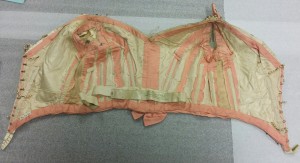Upcycling in Fashion
By: Jeanmarie Tucker
As the costume collection rehousing project continues, we find new and amazing articles of clothing each day. While bringing in more of the collection, we came across two amazing and show-stopping pieces, a bright salmon colored bodice and shift dress. The garments were structurally stable with minor wear on the bodice. The two pieces were made from the same fabric, however on further examination they did not go together. One wouldn’t wear the off-shoulder style bodice over the dress. Also, while the dress was clearly designed in 1920’s style, the bodice is more reminiscent of the late 19th century, with several modifications that make it hard to date precisely.
So, while the two pieces were made from the same 19th century silk faille fabric, they represented two completely different styles. Through close examination, we determined that the wearer repurposed or “upcycled” an older skirt into the shift dress. Women would often reuse material from older garments or alter dresses to imitate fashion trends. This process, which may completely change the style of the original piece, is called upcycling.
In this case, the original skirt that would have been worn with the bodice was remade into a shift dress in the late 1920s, when the shift was at the height of popularity. The skirt has a high-low hem and asymmetrical ruching on the back. The dress has a short train which would have dragged on the floor, evident by the staining visible on the underside of the train.
The bodice may also have been altered or upcycled at some point. First, the bow on the front and the ruched waistband appear to be later additions. Secondly, the decorative fabric along the back closure of the bodice were extended to form the extra two tails which would sit over of the skirt waistband.
Lastly, the off-shoulder sleeves appear to be later additions. The stitching around the armhole where the sleeves are attached to the bodice is messier than that elsewhere on the bodice. Furthermore the inner satin lining is more modern and does not match any other fabric on the garment.
It is unclear how often the original garment was worn or altered before this final iteration. The pieces could have been used for fancy dress or altered many times over generations, upcycled by each new owner.


